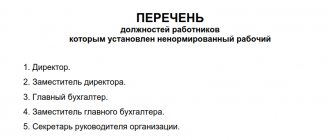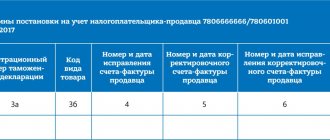When transferring fixed assets from one enterprise to another, a transfer and acceptance certificate is filled out, the unified form of this act is OS-1. Form OS-1 can be found at the end of the article; a sample of filling out the transfer and acceptance certificate is also presented there.
This form is used when you need to formalize the transfer or acceptance of one object. For buildings and structures, the act form OS-1a is used, here you can use this form, for a group of objects - form OS-1b.
Certificate of acceptance of transfer of fixed assets - where to download the form
The unified form OS-1 “Act on the acceptance and transfer of fixed assets (except for buildings, structures)” was approved by Decree of the State Statistics Committee of the Russian Federation dated January 21, 2003 No. 7. This form is available for free on our website:
Read about the use of independently developed document forms in the material “Primary document: requirements for the form and the consequences of violating it.”
Commissioning
Property comes to the organization in several ways: purchase, gratuitous transfer, exchange. But this does not mean that the received property is already ready for use and transferred to work. For registration, an act of commissioning of fixed assets is drawn up.
Commissioning is a term that means that a property begins to be used for its intended purpose at a given time. A special form reflects the fact that the fixed asset is suitable for use, has no deviations, damages or flaws and is ready to be used in the company’s activities.
There is no unified template for commissioning. The organization is obliged to develop its own form of the document and approve it in its accounting policies. It is allowed to use uniform report forms approved by the State Statistics Committee of Russia (Moscow).
The act of acceptance of the transfer of an object of fixed assets - how many copies should there be?
If there is an acceptance and transfer of a fixed asset between its former owner and the new owner, the act is drawn up in 2 copies: one for the transferring party, the other for the receiving party. In this case, it is compiled by the donating organization.
Both copies are approved by the heads of the recipient organization and the donating organization. The act is also accompanied by technical documentation related to the OS object.
Find out how to correctly take into account the receipt of OS when purchasing from ConsultantPlus. If you do not have access to the K+ system, get a trial online access for free.
When purchasing a new operating system, which is a product for the seller, or when introducing an object that the organization created itself, only 1 copy of the act is drawn up.
Commissioning procedure
Depending on the category of property, the commissioning algorithm varies. For ready-made objects, such as household appliances, equipment or transport, the order of putting into use is determined in one step. This is monitoring the readiness of the property and drawing up a commissioning report for the fixed asset.
If a complex asset is sent for commissioning, the procedure becomes much more complicated. For example, in relation to a constructed building or structure, the algorithm will be as follows:
- Preparation of technical documentation for commissioning (account logs, registers, conclusions).
- Drawing up a work completion report and its approval. Resolving issues, resolving problematic issues with the customer (by phone or in person).
- Examination of compliance with technical and safety requirements.
- Registration of relevant conclusions from the controlling ministries and departments that the facility is ready for operation.
- Coordination of construction with lawyers of the architectural and urban planning department of the municipality.
- Comprehensive inspection of the facility for readiness for commissioning.
- Preparation of expert opinions.
- Payment of state duties, contributions, fees.
- Registration of the building in Rosreestr (on the website or through the MFC), registration of ownership rights.
And only after all stages have been completed can the constructed building or structure be used for its intended purpose.
Sample filling - OS form 1 and its features
OS 1 – you will find a sample filling below, it is compiled on 3 pages. Before using the sample filling - form OS 1, you should understand that such a document is created only for registering a new fixed asset. When selling fixed assets, in the sample of filling out OS 1 (transfer and acceptance certificate), the receiving party should be sure to rewrite the information about the conclusion of the acceptance committee in the appropriate column.
The main feature for the sample of filling out OS 1 from the lessee is that a note is made in the act that the received object is being put into operation under a leasing agreement. Please note: this agreement must stipulate that the fixed asset is transferred to the lessee for balance.
Due to the fact that after the adoption of the new law on accounting since 2013, the use of unified forms is not mandatory, each accountant can edit the form of such a document in his own way. When adjusting the OS-1 transmission acceptance certificate, you should remember in which columns to display the required information.
Page 1 states:
- Certificate approval stamps. When purchasing/creating a new OS, the certificate of approval is not affixed by the donating organization.
Important! The stamps of the unified form OS-1 (the sample filling will help you figure this out) contain such details as the place of printing. At the same time, the seal is not listed among the mandatory details of the primary accounting document established by Part 2 of Art. 9 of the Federal Law of December 6, 2011 No. 402-FZ “On Accounting”. That is why, if an organization (receiver or deliverer of OS) has officially refused to use a seal (Federal Law No. 82-FZ dated April 6, 2015), it is not necessary to affix a stamp. This is confirmed by the letter of the Ministry of Finance of Russia dated 08/06/2015 No. 03-01-10/45390.
- Information about the organization that receives the OS.
- Information about the delivering organization. This attribute is filled in if the object is transferred as an OS. This is not required for new and independently created objects.
- Accounting information, including the account of the object, the date of acceptance/write-off of the object from the register.
- Information about the fixed asset itself: name, purpose, model, brand, location, information about the manufacturer, inventory and serial numbers, depreciation group number, etc.
The second page of the act contains 3 sections.
Section 1 is filled out only for objects that were used as fixed assets based on the data of the donating organization. It contains information about the asset as of the date of transfer, including the date of release, commissioning, overhaul, actual service life, useful life, as well as information on depreciation accrued by the former owner and the residual value of the fixed asset.
Section 2 is filled out only by the recipient organization in one (its own) copy. This provides information on the depreciation procedure for an object: its original cost, the useful life established by the new owner, as well as the method and rate of depreciation.
About depreciation of fixed assets in accounting, see:
- “Formula and example of the reducing balance method of depreciation”;
- “How to correctly apply the cumulative depreciation method?”
Section 3 contains a brief individual description of the fixed asset item. All its fixtures and accessories are reflected here, the content of precious metals (if present in the composition) and other characteristics of the object are indicated.
On the third page of the document:
- data on the acceptance of the OS by the commission (whether or not the object meets the technical specifications, whether it requires modification);
- signatures of competent persons: members of the acceptance committee and persons who handed over and accepted the object.
At the very end, accounting marks are added:
- the transferring organization - that the disposal of the object is reflected in the inventory card (filled out only when transferring fixed assets between owners);
- the receiving party - about opening an inventory card on the OS or about a corresponding entry in the inventory book.
How to fill out the act of acceptance and transfer of a building (structure) according to Form N OS-1a is described in detail in the Ready-made solution from ConsultantPlus. There you can also see a sample of the completed act. Trial access to K+ is free.
Agreement on the gratuitous transfer of property under the Civil Code of the Russian Federation
A loan agreement is a legal agreement that stipulates the rules for the owner to provide property to another person - the recipient of property for free.
It is regulated by Chapter 36 of the Civil Code of the Russian Federation and has the following mandatory features:
- The borrower is not required to take retaliatory steps;
- The borrower has no right to transfer the rights of use to another person.
- There is no fee for the provided property;
- The transaction is temporary or indefinite;
At its core, it is similar to a lease and loan agreement, so it is important to know their main differences:
- The loan is regulated by Chapter 42 of the Civil Code.
It states that in return the borrower can return the money or real estate. - Chapter 32 of the Civil Code states that when provided for free use, a change of owner occurs, that is, the time period is not clearly defined, and the same object of ownership is subject to return.
- According to Chapter 34 of the Civil Code, rent. In addition, the tenant must carry out only current repairs, while the recipient assumes obligations for both current and major repairs. There may be an exception if the agreement provides for another option.
The required information to be provided is as follows:
- Data of the lender and borrower;
- Cost assessment and documentary confirmation of the object;
- The purpose of the action;
- Information about the donated object;
- Duties and responsibilities of the parties to the transaction;
- Additional terms;
- Signatures.
- Costs of the borrower for repairs and maintenance;
This agreement can be drawn up for different purposes, between parties of different types, and accordingly the samples will vary.
A lawyer will tell you exactly how to draw up an agreement in a particular case. Find a professional in your area.
Certificate of acceptance of equipment transfer for installation - form OS-15
In some circumstances, enterprises have difficulty drawing up a report on received equipment that must be installed. Despite the apparent similarity with the form described above, a different OS-15 form is used here.
When receiving equipment for installation purposes, it has its own path: first of all, it goes to the warehouse, then it is assembled, and after testing, the object is transferred to the category of fixed assets.
Form OS-15 is issued when the equipment is installed at the enterprise. Filling out the form is not difficult, since it contains a standard set of details, lines and columns. This form is available on our website.
What is free use?
The transfer of property for free use implies the transfer of the property described in the contract (whether real estate or other property) to another person for a certain period of time with the possibility of using the object of the contract. At the same time, no fee is charged for its use, and upon expiration of the document, the property must be returned in the same form or in another form provided for by the agreement. The transfer of property itself in this case will be a loan.
If the transfer is not gratuitous, then the agreement will already be a lease, rental or loan agreement. Unlike a deed of gift, property is transferred temporarily, and not on a permanent basis with the transfer of property rights to another person.
Results
Form OS-1 is used when capitalizing an asset upon purchase. It is not necessary to use a unified form. You can develop the transfer and acceptance certificate yourself.
Sources:
- Resolution of the State Statistics Committee of the Russian Federation dated January 21, 2003 N 7
- Federal Law of December 6, 2011 N 402-FZ “On Accounting”
You can find more complete information on the topic in ConsultantPlus. Free trial access to the system for 2 days.
Popular
Payments to personnel Personnel records management Accounting statements Economics and business Pension Fund insurance premiums Accounting statements Economics and business Personnel records management Maternity leave Payments to personnel Accounting statements Foreign workers Labor relations Fines Payments to personnel Modern entrepreneur Taxes and accounting for small businesses © 2006 — 2021 All rights reserved. When using materials in full or in part, an active link to spmag.ru is required, subject to compliance.
Tips for an office employee:
- It is no secret that office work negatively affects both the physical and mental state of the employee. There are quite a lot of facts confirming both.
- Every person spends a significant part of his life at work, so it is very important not only what he does, but also with whom he has to communicate.
- We suggest you familiarize yourself with anti-tips that will tell you how not to talk to your boss as an office worker.
- Gossip in the workplace is quite commonplace, and not only among women, as is commonly believed.
Use of property and its return
The borrower is obliged to use the property for its intended purpose and ensure its safety. The property must be returned to its owner in the form in which it was received, taking into account, of course, its wear and tear. The property must be returned within the period specified in the agreement for gratuitous use.
If the agreement was concluded without specifying its validity period, then in this case both the borrower and the lender can terminate the agreement. The text of the agreement must indicate all those cases when the parties can refuse to fulfill the agreement.
For example, the borrower can return the property if he no longer needs it or if the lender has provided him with property that does not comply with the terms of the agreement.
And the lender may demand the return of the property, for example, in cases where the borrower uses the property for other purposes than its intended purpose. Important! All cases of early termination of the contract must be clearly indicated in its text.
Accounting
At the stage of concluding the contract, you can immediately agree on whose balance sheet the leased item will be listed. This determines how you account for the costs of maintaining the property and who will pay the property tax. It is more convenient to look at the main differences and features of accounting in.
When the property is taken into account by the lessor, . If the received property is taken into account on your balance sheet,... In a special order, it is also necessary for those related to the receipt of leased property (clause 50 of the Methodological Instructions, approved by order of the Ministry of Finance of Russia dated October 13, 2003.
No. 91n).
How to fill out the second page
Filling out the first page of the document is carried out as follows:
- Deliverer – details of the company transferring the object.
- Manufacturer – the name of the organization that manufactured the object.
- Account – account number. an account in which OS is accepted as a debit.
- The date when the object is accepted for accounting and put into use.
- Number and date of formation of the act.
- Recipient - the main details of the company that receives the OS: its full name, address, OKPO, bank details, contact information, as well as the name of the structural unit where the object is received.
- Location – the name of the company in which the object is located at the time of its transfer.
- Basis – the number and date of generation of the document on the basis of which the asset is transferred.
- Name, model and purpose of the transferred OS.
- Numbers – the depreciation group number is written down, as well as passport, inventory and serial numbers.
The second page of the OS-1 form consists of three sections. Consider how each of these sections is completed.
Reasons
If we are talking about accepting a donation by a budgetary institution, then you will need to first conclude a gift or donation agreement. The latter document is one of the types of gift agreement, but has its own nuances.
The donation agreement is described in detail in the first paragraph of Article 572 of the Civil Code of the Russian Federation. A donation can also be made orally (this is clearly stated in the first paragraph of Article 574 of the Civil Code of the Russian Federation), but only if:
- The donor is not a legal entity.
- There is no promise in the terms to give a gift in the future.
- A gift is movable property.
- The cost of material assets does not exceed 3 thousand rubles.
If the object of the gift is real estate, then such an agreement is additionally subject to state registration. In all other cases, a corresponding agreement is drawn up between the parties.
And the act of gratuitous transfer of material assets is simply an annex to it.
Moreover, the main functionality of this document is in a specific list of transferred goods.





